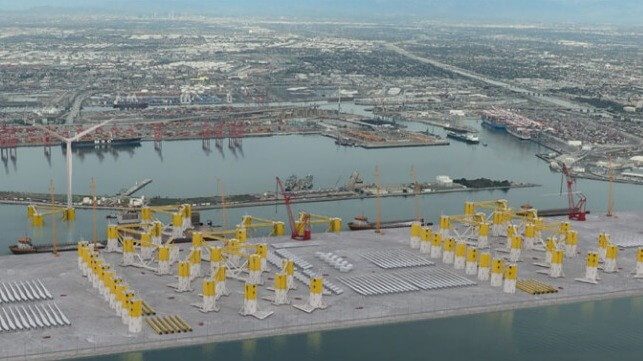Long Beach Releases Concept Study for Largest Offshore Wind Port

The Port of Long Beach released its First Conceptual Report for its vision to develop a wind port that would serve California’s emerging offshore wind energy industry. First revealed in the January 2023 State of the Port presentation, the concept is to create a 400-acre terminal known as Port Wind within the port that could be used for the manufacture, assembly, staging, and possibly the maintenance of offshore wind turbines.
The Port of Long Beach reports it is investing $1 million to develop a conceptual design and constructability assessment for the proposed Port Wind as it seeks to capitalize on the emerging opportunities in the new industry. The Bureau of Ocean Energy Management conducted the first ever California offshore wind lease auction in December 2022 as it looks to open the region to development, but cautioned that extensive infrastructure also needs to be developed to support the industry. BOEM performed a study to assess California ports and it indicated that there are limited existing ports that could host staging and integration operations.
The offshore wind industry in California will be confronted with challenging conditions. Unlike the U.S. East Coast, the Pacific Outer Continental Shelf is characterized by rapidly increasing water depths that exceed the limits of traditional fixed-bottom offshore wind turbines. It is anticipated that most of the development of offshore wind will use the more suitable floating wind technology, which currently calls for the assembly of the wind turbines on their foundations in a sheltered port and towing them to their location. BOEM in its report highlights the air height requirements, possibly as much as 1,100 feet, saying most existing ports do not have the needed clearances.
“Imagine fully assembled wind turbines capable of generating 20 megawatts of energy towed by sea from the Port of Long Beach to offshore wind farms in Central and Northern California,” said Port of Long Beach Executive Director Mario Cordero. “As society transitions to clean energy, our harbor is ideally located for such an enterprise – with calm seas behind a federal breakwater, one of the deepest and widest channels in the U.S., direct access to the open ocean, and no air height restrictions. No other location has the space to achieve the economies of scale needed to drive down the cost of energy for these huge turbines.”
In its concept study report, the port highlights the emerging opportunities noting that the Biden administration announced a goal for 15 GW of floating offshore wind by 2035. The California Energy Commission established its preliminary target of 2 to 5 GW by 2030 and 25 GW by 2045, while the governor has called for at least 20 GW by 2045 and directed state agencies to develop a strategic plan for offshore wind development.
Port Wind at Long Beach would be located in the Outer Harbor, just south of the Navy Mole and near the western border with the Port of Los Angeles on newly created land. Critically, this places it outside the Long Beach International Gateway Bridge meaning there would be no height limitations. Among the port improvements necessary to support the plan would be a deepening and widening of the main channel and the construction of approach channel and turning basin in addition to the landfill adjacent to Pier 400 in the Port of Los Angeles.
According to the concept study, Port Wind would be the largest facility specifically designed to accommodate the assembly of offshore wind turbines. The terminal would have the capability for heavy-lift crane operations to stage, store, and construct floating wind turbines. The concept calls for a flexible design so that it could host operations ranging from staging and integration to foundation fabrication, component manufacturing, maintenance, and support.
The port’s newly released concept study provides information to continue planning and discussion with state and federal officials, developers, and funders for the $4.7 billion project. Construction could potentially start in January 2027, with the first 100 acres operational in early 2031, the second 100 acres operational in late 2031, and the additional 200 acres coming online in 2035.
